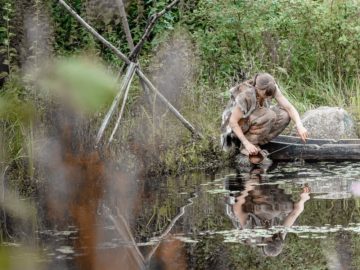Ian Gilligan in Smithsonian:
 Though many gaps in the story remain, the emerging evidence suggests clothing really had two origins: first for biological needs, then cultural. Archaeologists who study the Paleolithic or Stone Age tend to ignore clothing. Perhaps this isn’t surprising, considering not a single shred has survived from this ice age era between roughly 2.6 million and 12,000 years ago. Archaeologists are reluctant to look for something they will never find.
Though many gaps in the story remain, the emerging evidence suggests clothing really had two origins: first for biological needs, then cultural. Archaeologists who study the Paleolithic or Stone Age tend to ignore clothing. Perhaps this isn’t surprising, considering not a single shred has survived from this ice age era between roughly 2.6 million and 12,000 years ago. Archaeologists are reluctant to look for something they will never find.
Stone Age clothing may be invisible to archaeology, but that does not mean Paleolithic clothing origins cannot be investigated scientifically. For instance, fossils show humans inhabited ice age Eurasia when the frigid windchill reduced safe exposure times to an hour or two. Clearly, those people had adequate clothes. And, fortunately, tools used to make clothing, such as sewing needles, provide some tangible—albeit indirect—evidence.
It’s also helpful to distinguish between simple and complex clothing. Simple clothes hang loose, such as capes, cloaks or loincloths. They can be warm—a drapey fur cloak, for instance—but simple clothes are prone to wind penetration. Complex clothes hug the body snuggly, usually with separate sleeves or pantlegs. Also, complex clothes may have multiple layers.
More here.
